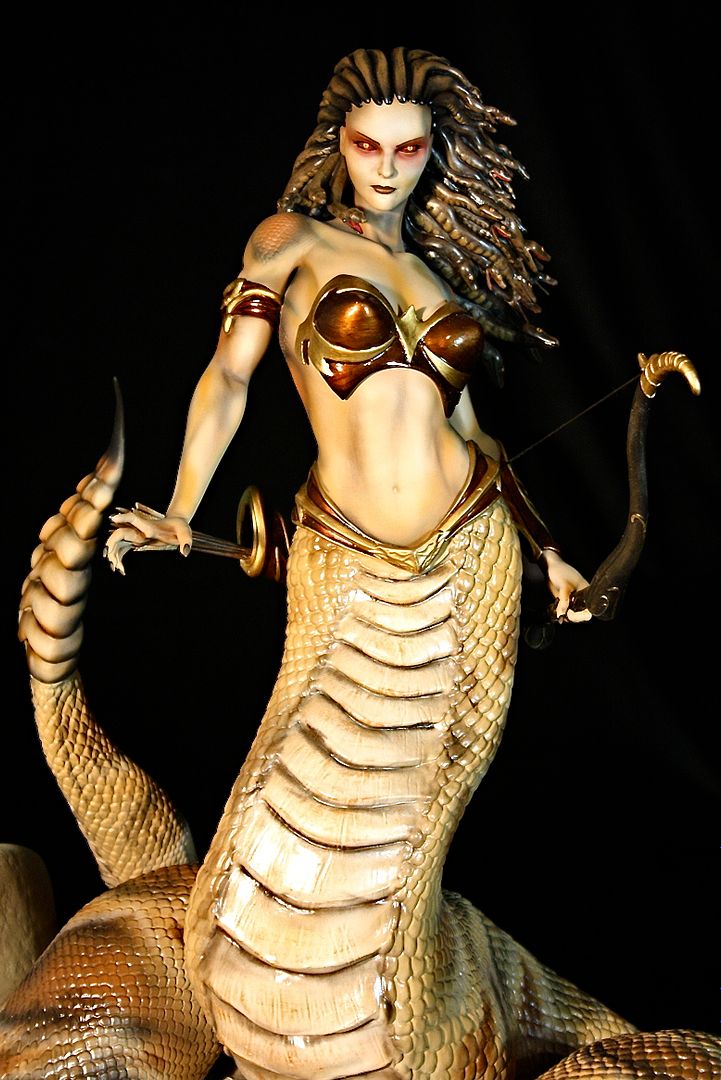 Submitted by Mara on
Submitted by Mara on

By Martha Leonard
The stories of Medusa are often contradictory. Was she a victim or a villain? Was she always ugly or once beautiful? How did someone with the body of a dragon and a head of snakes become known as thy "guardian or protectress"? Just what was her role in the early Greek myths?
The name Medusa first appears in early religious history, when goddesses represented birth and earth. It was a time before the advent of male gods. There are references to a Medusa among the Libyan Amazons. She was known then as the "serpent goddess". Those who study Greek mythology believe the goddess was transplanted into the Greek tales at a later date. All tales seem to agree that she was a gorgon - a terrible monster. Some stories say she was born that way, the only mortal of three gorgon sisters born to Echidne, a half-woman, half-snake and Typhon, the worst monster in the world. Another story states she was a beautiful woman born to two earth people named Phorcys and Ceto.
The story of Medusa as a world renowned beauty says she offended Athena, the beautiful goddess. One myth says Medusa lived in the far north and had never seen the sun. She asked permission of Athena to come south. When Athena denied her request, she angrily accused Athena of being jealous of her (Medusa's) beauty. Enraged, Athena not only removed her beauty, but even worse, made her so ugly people, especially men, turned to stone just looking at her.
A different story also reports Medusa's beauty was so stunning that many men courted her, but she became a priestess in Athena's temple. Her golden hair and her beauty attracted the lustful eyes of the sea god, Poseidon. They coupled in Athena's temple, a terrible violation of a sacred place. Stories differ as to whether he raped Medusa or she enticed him first. Either way, she got pregnant. When Athena learned what had happened she flew into a rage and cursed Medusa with snakes for hair, a body of a dragon and a face that turned those who looked at her to stone.
Eventually, a Greek hero named Perseus promised to kill her. He borrowed (some stories say he stole) Hermes' winged sandals and Hades' cap of invisibility. He carried a powerful scythe and a mirrored shield. His speed and invisibility allowed him to get close to her. He used the mirror to "see" her without becoming a stone and beheaded her. Again, different versions tell that Athena assisted him.
It turned out that the head continued, at least for awhile, to turn others to stone. Perseus used it to kill some of his enemies including King Polydectes who was forcing Persephus' mother to marry him. The story continues that when her head left her neck, her offspring sprang full grown from her blood. They were the winged horse Pegasus (Poseidon was a great horse lover) and a giant warrior named Chrysaor. As Perseus transported the head, blood dripped onto the Sahara Desert and created poisonous serpents. When he laid the head down near the sea, the blood seeped onto the seaweed and created red coral. Afterward this water was known as the "Red Sea". It is also interesting to note that some species of coral are called medusa today.
The eventual disposition of the head varies from tale to tale. Some say that Athena used it on her shield, the Aegis, for a while, and then gave it away. Others say Persephus buried it in the marketplace of Argos. Images of Medusa were found in the temples of Artemis, who also sometimes wore a Medusa mask at some rites. Her image was also found on doors, flags and in cups. It was used to scare evil spirits away.
There are lessons to be learned from Medusa's stories. One is that beauty can either be a gift or a curse, depending on how a beautiful woman behaves. Her beauty certainly got Medusa into trouble. The second lesson is that Medusa had more power as a gorgon than she did as a woman. This is how she became known as a guardian or protectress, especially for virgins. The curse of being able to turn men into stone proved to be a warning to all men who would force their unwanted attention on women. Finally, she continued to have power even after her death. Her head continued to kill and her blood spawned her children as well as snakes and coral. That power has continued even to modern times. Several books on women's rights and liberation have used Medusa's story along with her head as a symbol of rage. Perhaps every woman has a little of Medusa in her both as beauty and rage.
